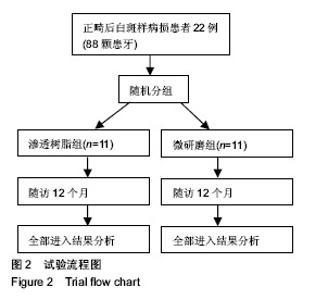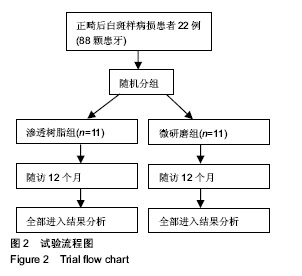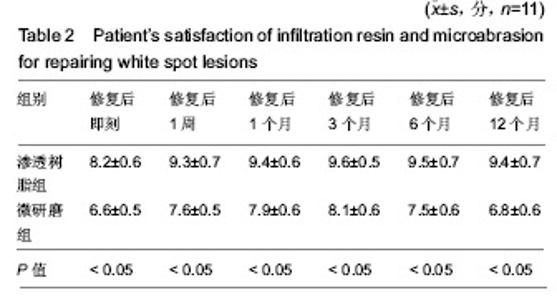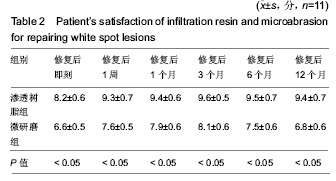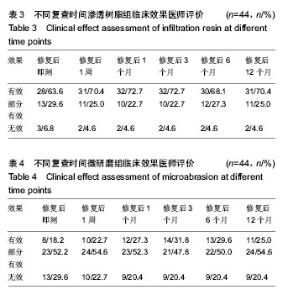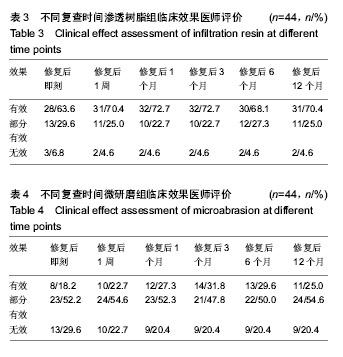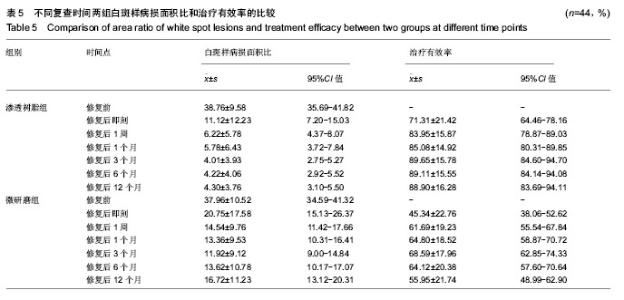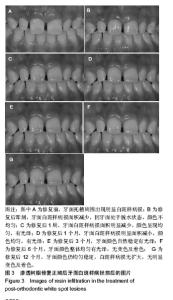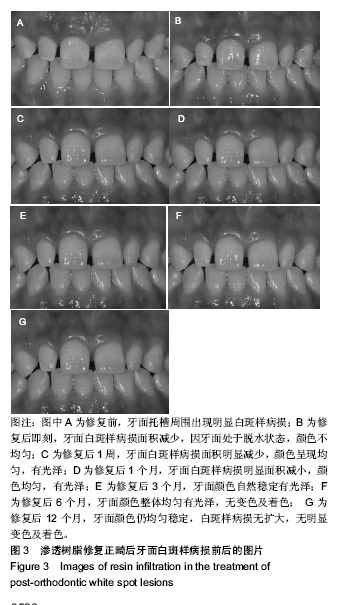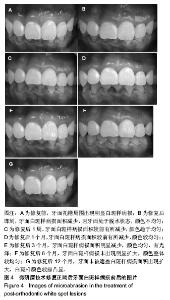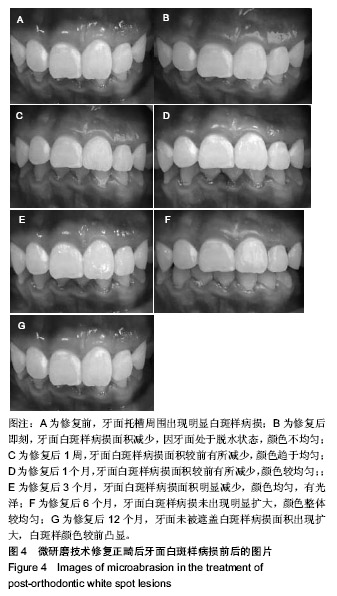| [1]Gorelick L,Geiger AM,Gwinnett AJ.Incidence of whitespot formation after bonding and banding.Am J Orthod. 1982; 81(2):93-98.[2]Boersma JG,van der Veen MH,Lagerweij MD,et al.Caries prevalence measured with QLF after treatment with fixed orthodontic appliances:Influencing factors.Caries Res. 2005; 39(1):41-47.[3]胡炜,王勤,傅民魁,等.口腔正畸固定矫治器应用中牙釉质脱矿的临床调查[J].口腔正畸学,2001,8(2):51-54.[4]Banks PA,Richmond S.Enamel sealants: A clinical evaluation of their value during fixed appliance therapy.Eur J Orthod. 1994;16(1):19-25.[5]Mattousch TJ,van der Veen MH,Zentner A.Caries lesions after orthodontic treatment followed by quantitative lightinduced fluorescence: a 2-yearfollow-up.Eur J Orthod. 2007;29(3): 294-298.[6]姚博文,许浩坤,王胜朝.含氟涂料和含氟牙膏对釉面再矿化和抗酸作用的实验研究[J].实用口腔医学杂志,2014,30(5):611-615.[7]Ogaard B. Prevalence of white spot lesions in 19-year-olds:a study on untreated and orthodontically treated persons 5years after treatment.Am J Orthod Dentofacial Orthop. 1989;96(5): 423-427.[8]Cury JA,Tenuta LM.Enamel remineralization: controlling the caries disease or treating early caries lesions.Braz Oral Res. 2009;23(Suppl1):23-30.[9]Benbachir N,Ardu S,Krejci I.Indications and limits of the microabrasion technique.Quintessence Int. 2007;38(10): 811-815.[10]Haywood VB.The ″bottom line″ on bleaching.Inside Dent. 2008; 4(2):82-89.[11]Knosel M,Attin R,Becker K,et al.External bleaching effect on the color and luminosity of inactive white-spot lesions after fixed orthodontic appliances.Angle Orthod. 2007;77(4): 646-652.[12]Paris S,Meyer-Lueckel H.Masking of labial enamel white spot lesions by resin infiltration-a clinical report.Quintessence Int. 2009;40(9):713-718.[13]Rocha Gomes Torres C,Borges AB,Torres LM,et al.Effect of caries infiltration technique and fluoride therapy on the colour masking of white spot lesions.J Dent. 2011;39(3):202-207.[14]Kim S, Kim EY, Jeong TS, et al. The evaluation of resin infiltration for masking labial enamel white spot lesions[J].Int J Paediatr Dent. 2011; 21(4):241-248.[15]冯晋,李颖超.渗透树脂用于早期龋的研究进展[J].口腔颌面修复学杂志,2014,15(3):176-178.[16]Paris S,Meyer-Lueckel H. Inhibition of caries progression by resin infiltration in situ. Caries Res.2010;44(1):47-54.[17]Belli R,Rahiotis C,Schubert EW,et al.Wear and morphology of infiltrated white spot lesions. J Dent.2011;39(5):376-385.[18]吴毓聪,王雅雯,李少登.渗透树脂对釉质白垩斑表面颜色稳定性的影响[J].中国美容医学,2017,26(12):74-76.[19]王涛,苗雷英,朱顶贵.紫外线照射老化对渗透树脂处理釉质白垩斑颜色稳定性的影响[J].口腔医学,2015,35(12):1013-1015.[20]Kotsanos N.An intraoral study of caries induced on enamel incontact with fluoride - releasing restorative materials.Caries Res.2001;35(3):200-204.[21]骆慧,贾德蛟,刘海霞.酪蛋白磷酸多肽/无定形磷酸钙复合物与氟化钠预防正畸托槽周围的牙釉质脱矿[J].中国组织工程研究, 2016,20(3):377-381.[22]张敏,李琳.多乐氟预防正畸过程中釉质脱矿的临床评价[J].牙体牙髓牙周病学杂志,2015,25(9):565-567.[23]吴娜,周学东,郝玉庆,等.氟对脱矿和再矿化牙釉质表面的影响[J].华西口腔医学杂志,2012,30(5): 493-497.[24]王天,李桂红.皓齿微研磨糊剂联合美白系统漂白氟斑牙临床效果分析[J].中国美容学,2016,25(10):63-66.[25]Ardu S,Benbachir N,Stavridakis M,et al.A combined chemomechanical approach for aesthetic management of superficial enamel defects.Br Dent J.2009;206(4):205-210.[26]冯朝华,楚小玉.渗透树脂治疗正畸后牙面白垩斑的一年疗效观察[J].北京大学学报:医学版,2013,45(1):40-43. [27]Zantner C,Martus P,Kielbassa MA.Clinical monitoring of the effect of fluorides on long-existing white spot lesions.Acta Odontologica Scandinavica.2006;64(2):115-122.[28]Karlsson L,Lindgren L,Trollsas K,et al.Effect of supplementaryamine fluoride gel in caries-active adolescents:a clinical QLF study.Acta Odontologica Scandinavica. 2007;65(5): 284-291. [29]Donly KJ,O’neill M,Croll TP.Enamel microabrasion:A microscopic evaluation of the “abrasion effect”.Quintessence Int.1992;23(3):175-179.[30]Akin M,Basciftci FA.Can white spot lesions be treated effectively?Angle Orthod.2012;82(5):770-775.[31]Murphy TC,Willmot DR,Rodd HD.Management of postorthodontic demineralized white lesions with microabrasion:a quantitative assessment.Am J Orthod Dentofacial Orthop.2007;131(1):27-33.[32]Paris S,Hopfenmuller W,Meyer-Lueckel H.Resin infiltration of caries lesions:an efficacy randomized trial.J Dent Res. 2010; 89:823-826.[33]Arnold WH,Gaengler P.Light-and electronmicroscopic study of infiltration of resin into initial caries lesions—a new methodological approach.J Microsc.2012;245(1):26-33.[34]Rocha Gomes Torres C,Borges AB,Torres LM,et al.Effect of caries infiltration technique and fluoride therapy on the colour masking of white spot lesions.J Dent.2011;39(3):202-207.[35]Knösel M,Eckstein A,Helms HJ.Durability of esthetic improvement following Icon resin infiltration of multibracket-induced white spot lesions compared with no therapy over 6 months:A single-center,split-mouth, randomized clinical trial.Am J Orthod Dentofacial Orthop. 2013;144(1): 86-96.[36]Meyer-Lueckel H,Paris S.Progression of artificial enamel caries lesions after infiltration with experimental light curing resins. Caries Res.2008;42(2):117-124.[37]徐辉,周新文,华幸,等.渗透树脂对正畸后脱矿牙釉质表面显微硬度的影响[J].口腔医学研究,2013,29(3):252-254.[38]Peters MC. Strategies for noninvasive demineralized tissue repair.Dent Clin North Am.2010; 54(3):507-525.?[39]Benson PE,Pender N,Higham SM.Enamel demineralisation assessed by computerised image analysis of clinical photographs.J Dent.2000;28(5):319-326.[40]谷希,高源,杨琳,等.渗透树脂治疗正畸后白垩斑美学效果的临床研究[J].实用口腔医学杂志,2015,31(5):678-681.[41]Artun J,Thylstrup A.A 3-year clinical and SEM study of surface changes of carious enamel lesions after inactivation.Am J Orthod Dentofacial Orthop.1989;95(4):327-333. [42]Paris S,Schwendicke F,Keltsch J,et al.Masking of white spot lesions by resin infiltration in vitro.J Dent.2013;41(5):e28-e34.[43]杨红丽,唐睿,黄珊珊,等.渗透树脂治疗固定矫治后前牙唇面白垩斑的临床观察[J].临床口腔医学杂志,2016,32(3):173-176.[44]赵晓一,高学军.渗透树脂处理釉质白垩斑的表面粗糙度及颜色稳定性[J].北京大学学报(医学版),2014,46(1):53-57. |
